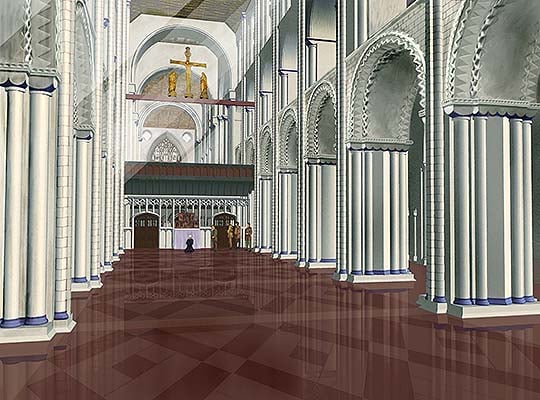Description of Thetford Priory
Besides the important 12th-century buildings on the site, there also survive an impressive 14th-century gatehouse, several medieval farm buildings (now in private ownership) and the remains of the prior’s lodging, which was converted into a farm in the 17th century.

The Church
The priory church was a large and elaborate building. Its proportions and detailing are similar to those of Castle Acre Priory, another Cluniac monastery founded in Norfolk in the same period.
The principal entrance to the nave – the most public area of the church – was through a façade set with two towers. Fragments of the rich architectural detailing of the façade can be seen in the foundations. Cluniac houses were celebrated for the richness of their furnishings and architecture, and from the fragmentary surviving evidence it is clear that the arcades of the nave had unusually complex detailing and that the interior was lavish.
The nave was divided from the transepts and presbytery by a screen extending across the whole interior. In the centre of the screen stood a nave altar, the base of which survives.
The east end of the church, where the community gathered for services, was originally shorter than it appears today, with a semicircular east end or apse. In the 13th century it was enlarged and squared off. At the same time a new Lady Chapel was constructed on the far side of the presbytery to house a miracle-working statue of the Virgin.
Between 1507 and 1510 a mason called Thomas Aldrych reconstructed the gable behind the high altar with a great window. Before the high altar lay the tombs of many patrons of the priory. In 1540 some were moved to Framlingham, where they can still be seen.
Buildings around the Cloister
The ruins of the extensive monastic complex extend southwards from the church. East of the cloister, the chapter house still has the remains of the monks’ bench around its walls and the bases of its supporting columns.
On the south side of the cloister was the refectory, where the monks gathered for meals. They ate in silence to the accompaniment of readings delivered from a raised pulpit near the high table. Evidence for the location of the pulpit is still visible on the walls.
Prior’s Lodging
West of the church and cloister is the lodging of the superior or prior of the monastery. Over the course of the Middle Ages this lodging evolved into a long, two-storey range, with its own chapel, chamber and hall.
The prior provided entertainment for guests or in celebration of important feasts. Surviving account books record the visit of Henry VII in 1498–9, when he was entertained by the waits of Norwich, who were paid 1 shilling and 4 pence for their performance.
Although the lodging remained in use as a house after the Suppression, with further alterations, by the 1820s it was a roofless ruin.
The Gatehouse
The great gatehouse is today the most perfectly preserved of the medieval priory buildings. Built in the late 14th century, it was the principal entrance to the walled precinct of the priory. A fragment of this wall survives to the left of the building.
The three-storey gatehouse stands intact apart from its floors, roof and parapet and remains almost unmodified. It had octagonal turrets at the south-east and south-west corners and is faced with flint and finely cut stone dressings. At each corner there are large projecting buttresses, one of which contains a stair to the upper floors.
The upper chambers were comfortably appointed with large windows and fireplaces, and may have been used for holding manor courts and receiving rents.
The barn beside the gatehouse originally had two gates on its inside face and two outer porches overlooking the road. This arrangement of entrances allowed wagons to drive into the building, drop off their loads under cover and then pass through the barn without reversing.
The wind tunnel created between the doors could also be used to blow away chaff when corn was being threshed. The barn was demolished in the 19th century but the V-shaped outline of its roof is still visible on the gatehouse wall.